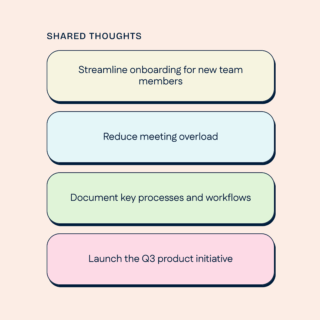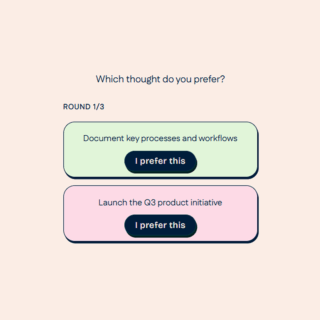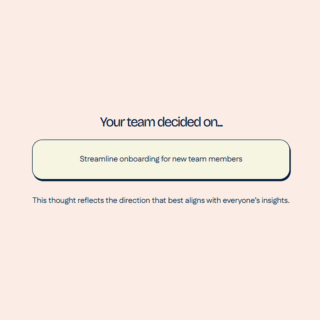1.7.2025
What Makes Decisions Time-Sensitive?
In a world where markets shift overnight and opportunities vanish in minutes, the ability to make fast, time-sensitive, and effective decisions isn’t just an advantage—it’s survival.
Picture this: Your team discovers a critical bug affecting 20% of your users. A competitor just announced a feature you’ve been developing for months. A key client wants an answer about contract terms by end of day. These moments demand swift action, yet many teams freeze, trapped in analysis paralysis while precious time slips away.
Enter the 5-Minute Decision Rule—a framework that helps teams make quality time-sensitive decisions when speed matters more than perfection.
Understanding Time-Sensitive Decisions
Time-sensitive decisions share common characteristics that distinguish them from routine business choices. They typically involve narrow windows of opportunity, escalating costs of delay, and situations where incomplete information is the norm rather than the exception.
What makes a decision truly time-sensitive? The answer lies in understanding the relationship between timing and value. When external factors—market conditions, competitive moves, customer expectations—create pressure for immediate action, traditional decision-making processes become liabilities rather than assets.
The 5-Minute Decision Rule
The 5-Minute Decision Rule is simple: For time-sensitive decisions, allocate exactly five minutes to gather essential information, weigh options, and commit to action. This isn’t about making reckless choices—it’s about recognizing that in many situations, a good decision made quickly beats a perfect decision made too late.
The rule operates on a fundamental principle: diminishing returns on deliberation. Decision quality often peaks within the first few minutes of consideration. Beyond that point, additional analysis frequently leads to overthinking, second-guessing, and paralysis rather than better outcomes.
When Time-Sensitive Decisions Demand Speed Over Perfection
Remember: the goal isn’t to use the 5-minute rule for every decision, but to recognize when speed creates more value than perfection.
The rule works best for:
✅ High-urgency, moderate-impact decisions where delay costs more than imperfection.
✅ Reversible decisions that can be adjusted if initial results prove suboptimal.
✅ Information-scarce situations where waiting for more data won’t significantly improve your choice.
✅ Competitive scenarios where first-mover advantage outweighs optimization.
Teams that recognize these situations in real-time can shift gears from deliberate analysis to rapid response mode, adapting their decision-making approach to match the situation’s demands.
The 5-Minute Framework in Action
⏱️ Minute 1: Frame the Decision. Clearly state what needs to be decided and the specific outcome you’re seeking. This prevents scope creep and keeps focus sharp. Write it down in one sentence.
⏱️ Minutes 2-3: Rapid Information Gathering. Collect only the most critical data. Resist the urge to research extensively—you’re looking for sufficient insight, not comprehensive analysis.
⏱️ Minute 4: Generate and Evaluate Options. Quickly brainstorm few viable options. For each, ask: What’s the best-case outcome? What’s the worst-case risk? What’s the most likely result? Don’t get bogged down in detailed scenarios.
⏱️ Minute 5: Decide and Commit. Choose the option with the best risk-reward profile given current constraints. Most importantly, commit fully to your choice and communicate it clearly to stakeholders.
The framework creates a structured approach to rapid decision-making that prevents the chaos often associated with rushed choices. Each minute has a specific purpose, ensuring critical steps aren’t skipped in the urgency to decide.
Real-World Applications
Startup Scenario: A SaaS company discovers their main competitor just launched a feature they’re developing. The 5-minute rule helps them quickly decide whether to pivot their roadmap, accelerate development, or differentiate their approach rather than spending days in strategy meetings while customers defect.
Customer Service Crisis: When a service outage affects thousands of users, teams can use the rule to rapidly choose between multiple response strategies rather than debating the perfect response while customer frustration mounts.
Project Management: Mid-sprint discoveries that could derail timelines benefit from quick decision-making. Teams can rapidly assess whether to push the deadline, reduce scope, or add resources without lengthy deliberation that further delays progress.
Manufacturing Crisis: When a key supplier suddenly becomes unavailable, production teams need immediate alternatives. The 5-minute rule helps evaluate backup suppliers, adjust production schedules, or modify product specifications without shutting down operations for extended planning sessions.
Tools for the 5-Minute Decision Rule
Modern decision-making tools can supercharge the 5-minute rule. Platforms like ATR Noni help teams quickly structure time-sensitive decisions, weigh options systematically, and maintain decision records for future learning—all within compressed timeframes.
Rather than replacing human judgment, these tools accelerate the decision process by providing frameworks, facilitating rapid input gathering, and ensuring nothing critical gets overlooked in the rush to decide.
Advanced platforms can automatically surface relevant historical decisions, provide risk assessment templates, and even simulate potential outcomes in real-time. This technological support transforms the 5-minute rule from a high-pressure exercise into a confident, systematic approach to rapid decision-making.
The 5-Minute Rule Using Noni
⏱️ Minute 1: Setup Noni Room Choose a name that clearly states what needs to be decided. This creates immediate clarity for all participants.

⏱️ Minutes 2-3: Gather Thoughts Collect thoughts from your team members rapidly. When time’s up, start the decision-making process immediately.

⏱️ Minute 4: Evaluate Options Brainstorm through the gathered thoughts efficiently. Noni compares each option 1-on-1, making decision-making fast and systematic.

⏱️ Minute 5: Decide and Commit Noni shows you the most preferred option after all comparisons are completed, providing clear direction for immediate action.

Making Speed Your Competitive Edge in Time-Sensitive Decisions
In an accelerating business environment, decision speed increasingly separates winners from also-rans. The 5-Minute Rule framework isn’t about being reckless—it’s about being strategically responsive to time-sensitive situations. It’s recognizing that perfect information rarely exists and that waiting for certainty often means missing opportunities entirely.
Teams that master time-sensitive decisions create competitive advantages that compound over time. They capture more opportunities, respond faster to threats, and maintain momentum while competitors deliberate.
The next time your team faces time-sensitive decisions, try the 5-minute rule. You might discover that good decisions made quickly often outperform perfect decisions made too late.
Key Takeaways
🎯 Time-Sensitive Decisions Involve:
- Narrow opportunity windows with escalating delay costs
- Competitive pressure and crisis situations
- Information-scarce environments where waiting doesn’t help
⏰ The 5-Minute Framework:
- Minute 1: Frame the decision in one sentence
- Minutes 2-3: Gather essential information rapidly
- Minute 4: Generate and evaluate options quickly
- Minute 5: Decide, commit, and communicate
🔧 Technology Support:
- Use platforms like Noni for structured rapid choices
- Leverage decision templates and frameworks
- Build real-time collaboration features
💡 Competitive Advantage: Remember that in dynamic markets, decision speed increasingly separates winners from also-rans. Teams that master time-sensitive decisions capture more opportunities and maintain momentum while competitors deliberate.

Ready to master time-sensitive decisions?
Try Noni and 5-minute decision rule for your next time-sensitive decision. Your team will thank you for the speed and clarity!




